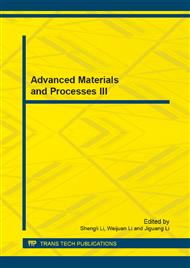p.68
p.72
p.76
p.80
p.84
p.88
p.96
p.100
p.104
Modulations and Core-Shell Effect on Positive Temperature Coefficient of Resistivity of Na0.5Bi0.5TiO3 Ceramics by Electrically Heterogeneous (LiCe) Phases
Abstract:
Positive temperature coefficients of resistivity (PTCR) have been realized in lead free Na0.5Bi0.5TiO3 (NBT) based ceramics by (LiCe) addition. The modulations on their volumes have been obtained continuously in the wide temperature range of 50-479 °C. X-ray diffraction and scanning electron microcopy results display that second-phase adulterants exit on NBT grain boundaries, and even create core-shell structures around NBT grains with the increment of additions. Impedance analysis reveals that electrically heterogeneous structures of grain and grain boundaries have contributions to the PTCR effects of NBT-based ceramics, especially for core-shell structure. All results indicate NBT-based system can be used for thermistor applications at high temperature.
Info:
Periodical:
Pages:
84-87
Citation:
Online since:
September 2013
Authors:
Price:
Сopyright:
© 2013 Trans Tech Publications Ltd. All Rights Reserved
Share:
Citation:


